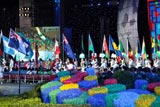The spirit of Shenzhen
Updated: 2011-07-05 09:01
By Chelsea Eakin (chinadaily.com.cn)
For some reason, Shenzhen seems to have a bad reputation. Most people envision a maze of factories, constantly churning out the cheap goods we all know and love. As the mother ship of "Made in China", Shenzhen is hard for people to imagine as a livable city.
 Chelsea Eakin and her language exchange partner, Kate, in Shenzhen's central park in an undated photo. [Photo provided to chinadaily.com.cn] |
In addition to several beaches, Shenzhen is home to a surprising number of green spaces, including a large park in the city center, a national mangrove and birdlife nature reserve, and several big lakes. From the top of Lotus Hill in Futian district, you can see mountains to the east of the city, and straight-ahead you see the peaks of the New Territories of Hong Kong. From the top of Wutong Mountain in Yantian district, you have a breathtaking view of one of the largest container ports in the world. You can let your imagination run wild about what sits inside those containers. Freshly made iPads? J.Crew's new Spring collection? Socks? Vacuums?
One of my favorite things about the city is that few people are actually from Shenzhen. For someone just beginning to learn Chinese, it's easy to strike up a conversation with anybody by asking them about their hometown. Taxi drivers are especially friendly, and for some of them I was the first foreigner that had ever ridden inside of their car. They always wanted to how I liked Shenzhen, if I had friends in the city, if I missed my home. And I could ask them all the same questions.
Shenzhen is a city of ambitions, thrumming with entrepreneurial spirit and a contagious youthful energy. I was inspired by my language exchange partner, Kate, a 19 year-old from Guangxi province who worked at a big electronics factory. At just 16, she came by herself to Shenzhen in order to earn money to send her brother to vocational school in Beijing. She taught herself English with the dream of quitting of her job at the factory, moving home and opening a language training center. I studied Chinese for Kate. Her self-motivation threw me into action. Each time we met, we kept pushing each other further along.
There's also no lack of art and architectural sites to be seen in Shenzhen. A good friend earning her Masters in Architecture back in America would often ask me if I had visited buildings she was studying in class. I would take pictures and email them to her. Dafen village, in the suburbs of the city, is said to be the largest mass producer of oil paintings in the world. You can wander the streets, surrounded by copycats of every imaginable famous painting ever made. But the village is definitely not devoid of creativity. The village's art museum is filled with original contemporary works.
Two weeks before I moved to Beijing, Kate left her job and opened an English school in her hometown with money she had saved. Her parents could barely believe it. Now, Kate and I are miles apart, but we still talk on the phone and commiserate about how we miss Shenzhen.
[Please click here to read more My China stories. You are welcome to share your China stories with China Daily website readers. The authors will be paid 200 yuan ($30). Please send your story to mychinastory@chinadaily.com.cn.]
Video

Working as a Universiade volunteer

Party starts as Universiade ends

Sumptuous seafood in Shenzhen

Athletes test doping knowledge
About Shenzhen

